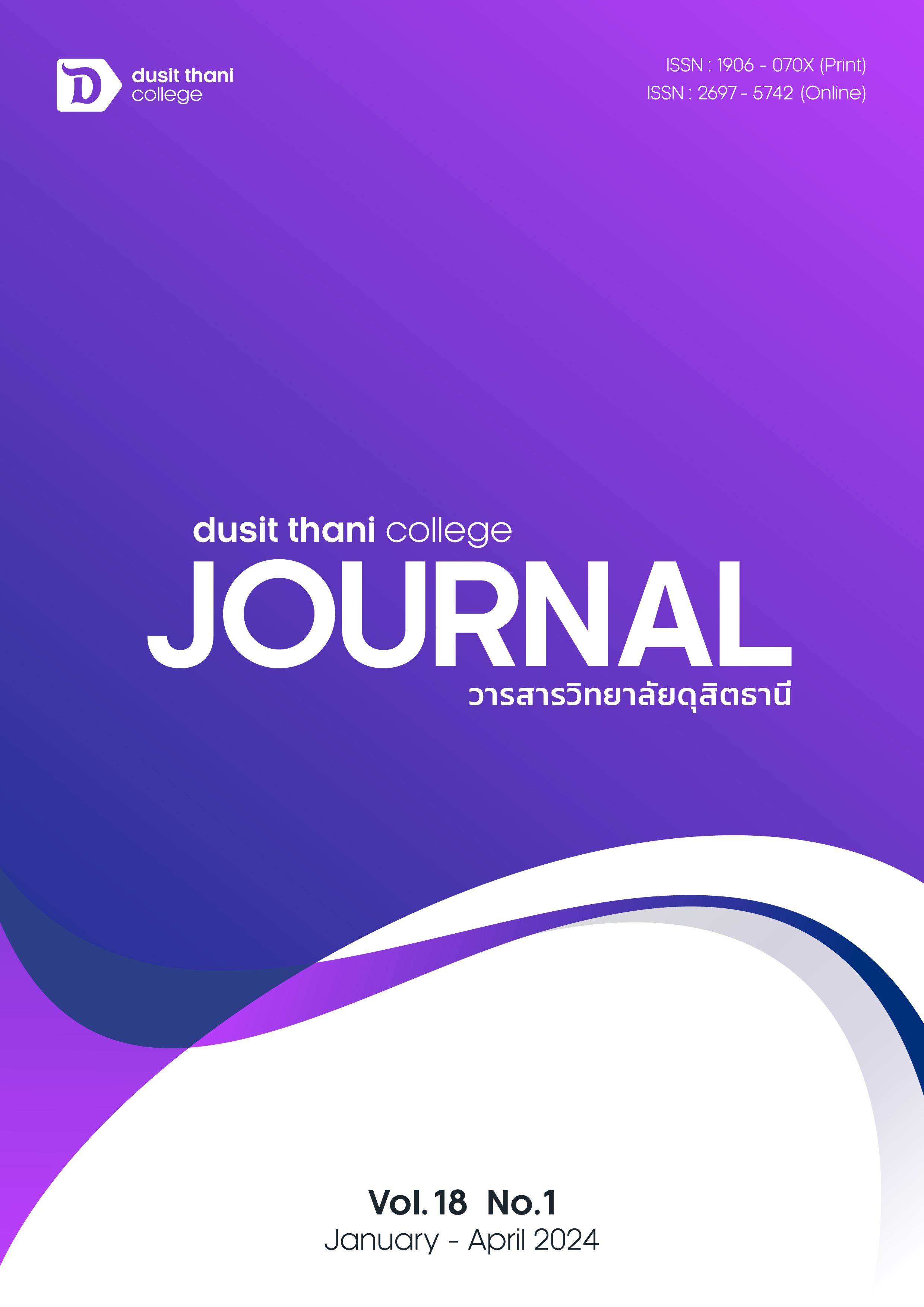การใช้แป้งข้าวสังข์หยดทดแทนแป้งสาลีในแผ่นแป้งตอร์ติย่าสำเร็จรูปแช่แข็ง
Main Article Content
บทคัดย่อ
การศึกษาครั้งนี้มีวัตถุประสงค์เพื่อ 1) ศึกษาสูตรพื้นฐานแผ่นแป้งตอร์ติย่า 2) ศึกษาปริมาณแป้งข้าวสังข์หยดที่เหมาะสมในแผ่นแป้งตอร์ติย่าแช่แข็ง 3) ศึกษาคุณภาพของแผ่นแป้งตอร์ติย่าแช่แข็ง จากแป้งข้าวสังข์หยด ประเมินผลโดยวัดค่าสี ค่า aw และประเมินคุณภาพทางประสาทสัมผัสในด้านลักษณะปรากฏ สี กลิ่น รสชาติ เนื้อสัมผัสและความชอบโดยรวม ด้วยวิธีการชิมแบบให้คะแนนความชอบ 9 ระดับ (9 – Point Hedonic Scale) ใช้ผู้ทดสอบชิม จำนวน 40 คน ผลการวิจัยพบว่าแผ่นแป้งตอร์ติย่าสูตรพื้นฐานทั้ง 3 สูตรมีคะแนนความชอบคุณลักษณะด้านสี และกลิ่น ไม่แตกต่างกัน (p>0.05) แต่คะแนนความชอบโดยรวม ลักษณะที่ปรากฏ และรสชาติ ผู้ทดสอบชิมให้คะแนนสูตรที่ 1 มากที่สุด (p≤0.05) โดยได้คะแนนเฉลี่ย 8.13, 8.08, 8.00, 8.03, 7.65 และ 8.13 ตามลำดับ ด้วยสูตรที่ 2 และ 3 ไม่มีส่วนผสมของน้ำมันพืชทำให้เนื้อสัมผัสของแผ่นแป้งตอร์ติย่าแข็งและกระด้าง เนื้อเปราะ แตกหักง่าย ผลการศึกษาการใช้แป้งข้าวสังข์หยดทดแทนแป้งสาลี ผู้ทดสอบชิมได้ให้ความชอบแผ่นแป้งตอร์ติย่าที่ใช้แป้งข้าวสังข์หยดทดแทนแป้งสาลีแต่ละระดับแตกต่างกันอย่างมีนัยสำคัญทางสถิติ (p≤0.05) โดยผู้ทดสอบชิมให้คะแนนสูตรที่ทดแทนแป้งสาลีร้อยละ 50 มากที่สุด ซึ่งมีส่วนผสมของแป้งสาลี 180 กรัม แป้งข้าวสังข์หยด 180 กรัม เกลือ 5 กรัม ผงฟู 5 กรัม น้ำมันพืช 60 กรัม น้ำสะอาด 220 กรัม ผลการศึกษาคุณภาพของแผ่นแป้งตอร์ติย่าสูตรพื้นฐาน และแผ่นแป้งตอร์ติย่าที่ใช้แป้งข้าวสังข์หยดทดแทนแป้งสาลีร้อยละ 50 เก็บรักษาที่อุณหภูมิ -18 องศาเชลเชียส พบว่าคุณภาพด้านจุลินทรีย์ที่ตรวจพบในแผ่นแป้งตอร์ติย่าที่ใช้แป้งข้าวสังข์หยดทดแทนแป้งสาลีไม่เกินข้อกำหนดโดยเปรียบเทียบกับมาตรฐานผลิตภัณฑ์ชุมชนโรตีกึ่งสำเร็จรูป (มผช.504/2547) คุณค่าทางโภชนาการของแผ่นแป้งตอร์ติย่าที่ใช้แป้งข้าวสังข์หยดทดแทนแป้งสาลีร้อยละ 50 ในน้ำหนัก 100 กรัม มีพลังงาน 399.32 กิโลแคลอรี โปรตีน 7.46 กรัม ไขมัน 16.32 กรัม คาร์โบไฮเดรต 55.65 กรัม เถ้า 2.6 กรัม ความชื้น 17.97 กรัม ซึ่งพบว่ามีปริมาณไขมันและเถ้าสูงกว่า แต่มีปริมาณโปรตีนต่ำกว่าแผ่นแป้งตอร์ติย่าสูตรพื้นฐานจากแป้งสาลี
Article Details

อนุญาตภายใต้เงื่อนไข Creative Commons Attribution-NonCommercial-NoDerivatives 4.0 International License.
นโยบายการพิจารณากลั่นกรองบทความ
- บทความวิจัยและบทความวิชาการทุกเรื่องที่จะได้รับการตีพิมพ์ต้องผ่านการพิจารณากลั่นกรองโดยผู้ทรงคุณวุฒิ (Peer Review) ในสาขาที่เกี่ยวข้อง จำนวน 3 ท่าน/บทความ
- บทความ ข้อความ ภาพประกอบและตารางประกอบที่ลงตีพิมพ์ในวารสารเป็นความคิดเห็นส่วนตัวของผู้เขียน กองบรรณาธิการไม่จำเป็นต้องเห็นด้วยเสมอไป และไม่มีส่วนรับผิดชอบใด ๆ ถือเป็นความรับผิดชอบของผู้เขียนแต่เพียงผู้เดียว
- บทความที่จะได้รับการตีพิมพ์จะต้องไม่เคยตีพิมพ์ เผยแพร่ที่ใดมาก่อน และไม่อยู่ระหว่างการพิจารณาของวารสารฉบับอื่น หากตรวจสอบพบว่ามีการตีพิมพ์ซ้ำซ้อน ถือเป็นความรับผิดชอบของผู้เขียนแต่เพียงผู้เดียว
- บทความใดที่ผู้อ่านเห็นว่าได้มีการลอกเลียนหรือแอบอ้างโดยปราศจากการอ้างอิง หรือทำให้เข้าใจผิดว่าเป็นผลงานของผู้เขียน กรุณาแจ้งให้กองบรรณาธิการวารสารทราบจะเป็นพระคุณยิ่ง
เอกสารอ้างอิง
Agricultural Research Development Agency (Public Organization). (2023). What are the benefits of wheat varieties? What can they be used for?. Retrieved from https://www.arda.or.th/knowledge_detail.php?id=65
Apitchaya Huangthong. (2021). Development of gluten-free bread products from bue su polo rice flour and flour. Bue Su Popi rice affects the physical and sensory qualities of the product. Master of Science Thesis, Graduate School Silpakorn University
Brandage Marketing Resources. (2019). Taco Bell has arrived in Thailand. First branch at The Mercury Ville at Chidlom shopping center. Retrieved from https://brandage.com/article/ 10096
Industrial Standards Institute. (2004). Community product standards: Instant roti, M.P.C. 504/2004.
Nantiya Phanomchan, Saowakon Chandam and Waraporn Phetkaew. (2018). Seed quality characteristics and structure. Of the food storage parts in Sangyod rice, opaque and clear seeds. Thaksin University Journal, 21(3) (Special Issue) Thaksin University 28th National Academic Conference 2018 (May - October 2018), 82-90.
Piyawan Techasirinukul, Marut Huabchan, Chonticha Aramwechaworanun, and Sarita Inthasak. (2019). Development of tortilla flour from germinated brown rice flour. Central Vocational Education Journal, 3(2), 70-75.
Pimpen Phonchalermphong and Nithiya Rattanapanon. (2010). Tortilla / Tortilla. Retrieved from https://www.foodnetworksolution.com/wiki/word/1733/tortilla
Phonrat Sinchaipanich, Kulraphat Butphong, Sasapin Disanil and Renu Tawichatwitthayakul. (2017). Effects of rice and rice berry flour used in place of wheat flour in brownies: texture and quality characteristics. MSOD Research Journal, Science and Technology Branch 10 (2): May-Aug 2017
Rimping Supermarket. (2024). Origin and History of the Tortilla? Retrieved from https://www.blockdit.com/posts
Sarita Phanthian. (2021). International desserts and pastries. College of Service Industry Management Suan Sunandha Rajabhat University


